Top Things To Do In Pamukkale
Pamukkale is a town in Turkey's southwestern Denizli Province, known for its natural hot springs, white travertine terraces, and ancient Greco-Roman city of Hierapolis.

Here are Some Things to do in Pamukkale, Turkey:
Explore The Cotton Castle:
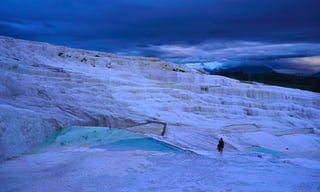
Pamukkale is famous for its unique natural wonder, the Cotton Castle. Take off your shoes and walk on the travertine terraces formed by mineral-rich thermal waters, which create a stunning white landscape resembling cotton.The Cotton Castle, also known as Pamukkale, is a unique natural wonder located in southwestern Turkey. It is a must-visit destination known for its striking white terraces of mineral-rich thermal waters. Here's what you can expect when exploring the Cotton Castle:
- Calcium Terraces: The main attraction of Pamukkale is its cascading white terraces formed by mineral-rich thermal waters. Over thousands of years, the flowing water has deposited calcium carbonate, creating stunning travertine formations that resemble a cotton-like castle. These terraces are visually breathtaking and provide a picturesque backdrop for photography.
- Thermal Pools: As you explore the Cotton Castle, you'll have the opportunity to dip your feet or even swim in the thermal pools. The warm and mineral-rich waters are believed to have therapeutic properties and have been used for centuries for their healing benefits. It's a relaxing and rejuvenating experience to soak in the natural pools amidst the beautiful surroundings.
- Hierapolis Ancient City: At the top of the terraces, you'll find the ancient city of Hierapolis. This UNESCO World Heritage Site is an archaeological marvel that dates back to the Hellenistic period. You can explore the well-preserved ruins of ancient temples, a theater, a necropolis, and a Roman bath complex. The Necropolis of Hierapolis is particularly notable, featuring well-preserved tombs and elaborate sarcophagi.
- Hierapolis Archaeological Museum: Within the Hierapolis site, you'll find the Hierapolis Archaeological Museum. It houses an impressive collection of artifacts excavated from the ancient city, including statues, ceramics, and architectural fragments. The museum provides insights into the daily life and history of Hierapolis and the surrounding region.

- Cleopatra's Pool: Located near the Cotton Castle, Cleopatra's Pool is a thermal pool that is said to have been visited by Cleopatra herself. It is believed to have healing properties and is a popular spot for swimming. The pool is surrounded by ancient ruins, adding to its historical charm.
- Nature Walks and Hiking: Pamukkale offers scenic nature walks and hiking trails that allow you to explore the surrounding landscapes. You can take leisurely strolls along the terraces or venture into nearby valleys, such as the Kaklik Cave Valley, for more natural wonders.
- Photography Opportunities: The surreal beauty of the Cotton Castle provides abundant photo opportunities. From capturing the white terraces in different lighting conditions to photographing the ancient ruins and the panoramic views of the surrounding countryside, Pamukkale offers endless possibilities for capturing stunning images.
When visiting the Cotton Castle, it's important to respect the natural environment and follow guidelines to preserve the integrity of the site. Remember to wear appropriate footwear to protect the delicate terraces, bring a towel and swimwear if you plan to take a dip, and carry drinking water and sunscreen for your comfort. Exploring the Cotton Castle is a truly unique experience that combines natural beauty, ancient history, and relaxation, making it a highlight of any visit to Turkey.
Visit Hierapolis:
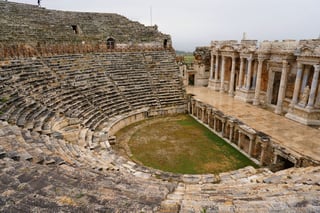
Explore the ancient city of Hierapolis, which was built above Pamukkale. Marvel at its well-preserved ruins, including the theater, the necropolis, the Roman baths, and the ancient agora.Hierapolis is an ancient city located in southwestern Turkey, near the town of Pamukkale. It is an archaeological site of great historical and cultural significance. Here's what you can expect when visiting Hierapolis:
- Ancient Ruins: Hierapolis was founded in the 2nd century BC and flourished under the Roman Empire. The site is home to a wealth of well-preserved ancient ruins, including a theater, temples, a gymnasium, a necropolis, and various public buildings. The theater is particularly impressive, offering panoramic views of the surrounding landscape.
- Hierapolis Archaeological Museum: Within the Hierapolis site, you'll find the Hierapolis Archaeological Museum. The museum houses a fascinating collection of artifacts excavated from the ancient city, including statues, mosaics, pottery, and inscriptions. It provides insights into the daily life, culture, and history of Hierapolis and the surrounding region.
- Necropolis: The Necropolis of Hierapolis is one of the largest ancient cemeteries in Turkey. It is a vast complex of tombs, sarcophagi, and burial chambers that extend over a significant area. The necropolis showcases various architectural styles and provides a glimpse into the funerary practices of the ancient city.
- Plutonium and Sacred Pool: Hierapolis was believed to be a sacred city with healing powers. The Plutonium, located within the site, was considered an entrance to the underworld and emitted toxic gases. The nearby Sacred Pool, also known as the Antique Pool, is a thermal pool that was believed to have therapeutic properties. Visitors can swim in the pool and admire the ancient ruins submerged in its waters.
- Pamukkale Travertines: Hierapolis is located adjacent to the stunning travertine terraces of Pamukkale. These white mineral-rich formations, created by the flow of thermal waters, are a UNESCO World Heritage Site and a natural wonder. The terraces provide a picturesque backdrop to the ancient city and offer opportunities for leisurely walks and photography.
- Hierapolis Theater Festival: If you visit Hierapolis during the summer months, you might have the chance to attend the annual Hierapolis Theater Festival. The festival features various theatrical performances, concerts, and cultural events that bring the ancient theater to life.
When visiting Hierapolis, it's important to respect the historical and archaeological significance of the site. Follow the designated paths, avoid climbing on the ruins, and refrain from taking or touching any artifacts. Wear comfortable shoes, carry drinking water, and consider bringing sunscreen and a hat as the site can be exposed to the sun.
Take a Dip in The Cleopatra's Pool:

Pamukkale's thermal waters also offer the opportunity to relax and swim in Cleopatra's Pool, believed to have been frequented by Cleopatra herself. The warm, mineral-rich waters are said to have therapeutic properties. Cleopatra's Pool, also known as the Antique Pool or Cleopatra's Bath, is a unique and historical attraction located within the Hierapolis-Pamukkale UNESCO World Heritage Site in Turkey. Here's what you can expect when visiting Cleopatra's Pool:
- Historical Significance: Cleopatra's Pool is a thermal pool that dates back to ancient Roman times. According to legends, it is believed that the pool was a gift from Mark Antony to Cleopatra during their honeymoon in the 1st century BC. It is said that Cleopatra herself swam in the pool and enjoyed its healing properties.
- Thermal Waters: The pool is fed by natural hot springs with warm mineral-rich waters that are known for their therapeutic qualities. The temperature of the water remains constant at around 36-38 degrees Celsius (97-100 degrees Fahrenheit) throughout the year. The minerals in the water are believed to have various health benefits, such as improving circulation and soothing muscle aches.
- Unique Setting: Cleopatra's Pool is situated amidst the ruins of ancient Hierapolis. As you swim in the pool, you can enjoy the stunning views of the surrounding ancient columns and remnants of the Roman city, creating a blend of history and relaxation.
- Underwater Antiquities: One of the unique aspects of Cleopatra's Pool is the presence of ancient artifacts scattered on the pool floor. These artifacts include marble columns, capitals, and fragments of the ancient city. Swimming in the pool gives you the opportunity to observe and even touch these remnants of the past.
- Swimming Experience: Cleopatra's Pool is open for visitors to enjoy a swim in its warm mineral waters. The pool is relatively large and can accommodate a considerable number of people. The depth varies from shallow to deeper areas, allowing both swimmers and non-swimmers to enjoy the experience. There are also sections with built-in steps and handrails for easy access into the pool.
When visiting Cleopatra's Pool, it's important to follow the rules and guidelines set by the authorities. Be respectful of the historical significance of the site and avoid damaging or removing any artifacts. Remember to bring your swimwear, towels, and any personal items you may need for a comfortable swim. It's a unique opportunity to relax in a historical setting while enjoying the natural benefits of the thermal waters.
Wander Through The Hierapolis Archaeology Museum:
Located near the ancient city, the Hierapolis Archaeology Museum houses a collection of artifacts and exhibits that provide insights into the history and culture of the region.The Hierapolis Archaeology Museum, located in Pamukkale, Turkey, is a must-visit destination for history enthusiasts. Here's what you can expect when wandering through the museum:
- Rich Historical Collection: The museum houses a diverse collection of artifacts and exhibits that showcase the rich history of the ancient city of Hierapolis. The artifacts date back to different periods, including Hellenistic, Roman, and Byzantine eras.
- Ancient Artifacts: As you explore the museum, you will come across a wide range of ancient artifacts, including sculptures, statues, pottery, jewelry, and everyday objects. These artifacts provide insights into the daily life, culture, and artistry of the ancient inhabitants of Hierapolis.
- Archaeological Discoveries: The museum displays various archaeological discoveries made in Hierapolis and its surrounding areas. These discoveries help reconstruct the city's history, architecture, and urban planning. You can see fragments of buildings, tombs, and religious structures, providing a glimpse into the city's past.
- Highlights of the Museum: Some notable highlights of the Hierapolis Archaeology Museum include the beautiful statue of Apollo, the unique sarcophagi with intricate carvings, and the well-preserved ancient theater masks. The exhibits are well-organized, providing a chronological journey through the history of Hierapolis.
- Interpretive Information: The museum provides informative descriptions, explanations, and visuals to enhance your understanding of the artifacts and their historical context. You can learn about the significance of each piece and its relevance to the ancient city's culture and society.
- Cultural and Educational Experience: The museum not only offers a glimpse into the past but also provides a cultural and educational experience. It helps visitors appreciate the significance of Hierapolis in the region's history and its contributions to ancient civilizations.
- Visitor Facilities: The museum is well-maintained and provides visitor facilities such as restrooms, a café, and a gift shop. You can take your time exploring the exhibits and make use of the amenities available.
When visiting the Hierapolis Archaeology Museum, it's advisable to allocate enough time to fully appreciate the exhibits and learn about the fascinating history of Hierapolis. You may want to have a guide or audio guide to enhance your understanding of the artifacts and their historical context. The museum is an excellent complement to exploring the archaeological site of Hierapolis and adds depth to your overall experience of the ancient city.
Hike The Pamukkale Nature Park:

Explore the scenic trails of the Pamukkale Nature Park, which surrounds the Cotton Castle. Enjoy panoramic views of the terraces, lush landscapes, and the nearby town of Denizli.Hiking the Pamukkale Nature Park in Pamukkale, Turkey, offers a unique and picturesque experience. Here's what you can expect when embarking on a hike in the park:
- Natural Beauty: Pamukkale Nature Park is known for its stunning natural landscapes. The park is characterized by its white terraces formed by mineral-rich thermal waters cascading down the hillside. The terraces, created over thousands of years, create a visually striking sight against the surrounding greenery.
- Terraced Pools: The terraced pools of Pamukkale, known as travertines, are a highlight of the hike. These pools are filled with warm, mineral-rich water that is believed to have therapeutic properties. As you hike up the terraces, you can take off your shoes and walk along the warm and soft limestone formations, enjoying the sensation and the unique views.
- Ancient Ruins: Along the hike, you will also encounter ancient ruins from the Roman period. The city of Hierapolis, located adjacent to the Pamukkale terraces, was a thriving Roman spa town. You can explore the remains of the ancient city, including the well-preserved theater, the Roman bath complex, the necropolis, and the Apollo Temple.
- Spectacular Views: As you ascend the terraces and explore the park, you'll be rewarded with breathtaking views of the surrounding landscape. From the top of the terraces, you can enjoy panoramic vistas of the white travertines, the lush greenery, and the distant mountains. The contrast of colors and the natural beauty of the area make for unforgettable sights.
- Nature Walks and Trails: The Pamukkale Nature Park offers designated trails and pathways for visitors to explore. These trails take you through different sections of the park, allowing you to appreciate the diverse flora and fauna. You can enjoy a leisurely nature walk, follow the marked trails, or hire a local guide for a more informative experience.
- Relaxation and Swimming: After your hike, you have the opportunity to relax and swim in the thermal pools of Pamukkale. The warm waters are believed to have healing properties and can be a rejuvenating experience after a long hike. The pools are terraced, providing various depths for both wading and swimming.
- Visitor Facilities: The Pamukkale Nature Park provides visitor facilities, including changing rooms, showers, and lockers, allowing you to freshen up after your hike. There are also cafes and picnic areas where you can rest and enjoy refreshments while taking in the natural surroundings.
Hiking in the Pamukkale Nature Park offers a blend of natural beauty, ancient history, and relaxation. It's important to wear comfortable footwear suitable for walking on the limestone terraces and bring sunscreen, a hat, and plenty of water, as the area can get hot. Following the designated trails and respecting the park's rules will help preserve the natural environment for future visitors to enjoy.
Visit The Ancient City of Laodicea:
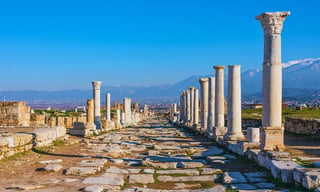
Located near Pamukkale, the ancient city of Laodicea is another archaeological site worth visiting. Explore its ruins, including the stadium, the theater, and the monumental arches.Visiting the Ancient City of Laodicea, located near Pamukkale in western Turkey, offers a fascinating glimpse into the region's rich history. Here's what you can expect when exploring this archaeological site:
- Historical Significance: Laodicea was an important city in ancient times and played a significant role in the Roman, Byzantine, and Christian eras. It was known for its wealth, trade, and cultural contributions.
- Well-Preserved Ruins: The archaeological site of Laodicea showcases well-preserved ruins that provide insights into the city's past. You can explore various structures, including the stadium, theater, amphitheater, and ancient streets. The ruins offer a glimpse into the city's urban planning and architectural achievements.
- Ancient Theatrical Performances: The theater of Laodicea is one of the main attractions, and occasionally, theatrical performances and cultural events take place here, allowing visitors to experience the site's historical ambiance.
- Sacred Sites: Laodicea was known for its religious diversity, and you can explore the remains of several ancient places of worship, including temples, churches, and a synagogue. These sacred sites reflect the city's cultural and religious heritage.
- Museum and Interpretive Center: The site features a museum and interpretive center where you can learn more about the history and significance of Laodicea. The exhibits showcase artifacts, sculptures, and inscriptions discovered during excavations, providing additional context to the ancient city.
- Panoramic Views: As you explore the site, you'll be treated to panoramic views of the surrounding landscape. The elevated position of Laodicea offers vistas of the nearby valleys and mountains, enhancing the overall experience.
- Historical Signage: The site is well-marked with informative signage and explanations in multiple languages, allowing visitors to learn about the significance and history of each structure and area.
- Visitor Amenities: The site provides facilities such as restrooms, seating areas, and shaded spots where you can take a break and appreciate the surroundings. It's advisable to wear comfortable shoes and bring water, as the site involves walking on uneven terrain.
Visiting the Ancient City of Laodicea offers a captivating journey back in time, allowing you to explore the remnants of an ancient city and gain a deeper understanding of its historical importance. The combination of well-preserved ruins, cultural diversity, and scenic views make it a noteworthy destination for history enthusiasts and those interested in ancient civilizations.
Enjoy a Pamukkale Sunset:
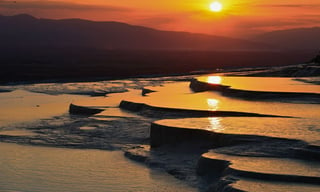
Experience the magical beauty of Pamukkale at sunset when the terraces are bathed in golden light. Find a peaceful spot and admire the breathtaking views as the sun sets over the landscape. Experiencing a Pamukkale sunset is a magical and unforgettable experience. Here's what you can expect when enjoying the sunset at this natural wonder:
- Unique Setting: Pamukkale's terraces, made of travertine mineral-rich deposits, create a surreal landscape that glows in warm hues as the sun begins to set. The combination of the white terraces, cascading pools, and the surrounding natural beauty creates a picturesque setting for a sunset viewing.
- Changing Colors: As the sun descends on the horizon, the colors of the sky transform, painting a breathtaking scene. Shades of orange, pink, and purple blend together, casting a soft glow on the cascading pools and the limestone terraces, creating a dreamlike atmosphere.
- Peaceful Atmosphere: As the daylight fades, the area becomes quieter, providing a serene ambiance. The diminishing crowds offer a more intimate experience, allowing you to immerse yourself in the tranquility of the surroundings and appreciate the beauty of nature.
- Scenic Views: The panoramic views from Pamukkale offer a stunning backdrop for the sunset. You can witness the changing colors of the sky reflecting on the thermal pools and terraces, creating a mesmerizing reflection. Don't forget to capture the captivating moments with your camera to cherish the memories.
- Relaxation and Reflection: Watching the sunset at Pamukkale is an opportunity for relaxation and reflection. Take a moment to pause, absorb the beauty of the natural surroundings, and appreciate the wonders of the world. It's a perfect time to appreciate the harmony between nature and human existence.
- Afterglow: After the sun has set, the fading light casts a gentle glow over the terraces, creating a peaceful and mystical atmosphere. This afterglow adds another layer of beauty and tranquility to the scene, making it a memorable experience.
- Peaceful Stroll: After enjoying the sunset, take a leisurely stroll along the terraces and enjoy the serenity of the area. You can further explore the travertine formations and nearby areas, such as Hierapolis, to extend your experience and fully embrace the unique atmosphere.
Remember to bring appropriate clothing, as temperatures can drop after sunset, and consider bringing a tripod if you're interested in capturing long-exposure photographs. Whether you're with friends, loved ones, or enjoying a solo adventure, watching the sunset at Pamukkale is an enchanting experience that will leave you with lasting memories of natural beauty and tranquility.
Visit Karahayit:
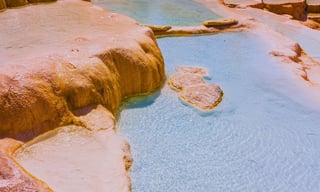
Visiting Karahayit is a unique experience that offers a different perspective of the Pamukkale region. Here's what you can expect when exploring Karahayit:
- Red Springs: Karahayit is known for its red-colored hot springs, which are rich in iron oxide minerals. These natural springs create a captivating sight with their vibrant red and orange hues, making it a popular attraction for visitors.
- Health and Wellness: The hot springs in Karahayit are renowned for their healing properties. Many visitors come here to enjoy the therapeutic benefits of the mineral-rich waters, which are believed to have various health benefits, including skin rejuvenation and relaxation.
- Thermal Hotels and Spas: Karahayit is home to a range of thermal hotels and spas that offer a unique wellness experience. You can indulge in soothing thermal baths, enjoy rejuvenating spa treatments, and immerse yourself in a serene and relaxing atmosphere.
- Cultural Experience: In addition to its natural beauty, Karahayit provides an opportunity to experience Turkish culture and hospitality. You can interact with locals, try traditional Turkish cuisine, and learn about the customs and traditions of the region.
- Peaceful Atmosphere: Karahayit offers a more tranquil and serene environment compared to the bustling areas of Pamukkale. It provides a peaceful escape where you can unwind, relax, and enjoy the therapeutic benefits of the hot springs in a less crowded setting.
- Scenic Surroundings: Karahayit is surrounded by beautiful landscapes, including lush green fields and rolling hills. The natural beauty of the area adds to the overall experience, providing a picturesque backdrop for your visit.
- Outdoor Activities: Karahayit offers opportunities for outdoor activities such as hiking, walking, and cycling. You can explore the surrounding countryside, enjoy nature walks, or embark on guided tours to discover the hidden gems of the region.
- Local Market: Karahayit has a local market where you can find unique handicrafts, souvenirs, and local products. It's a great place to immerse yourself in the local culture and pick up some memorable items to take home.
When visiting Karahayit, it's important to respect the natural surroundings and follow any guidelines provided by the local authorities. Remember to bring suitable attire for enjoying the hot springs and consider bringing a towel or swimsuit if you plan to indulge in the thermal baths. Enjoy the unique experience of Karahayit and take the time to relax and rejuvenate in this enchanting part of Pamukkale.
